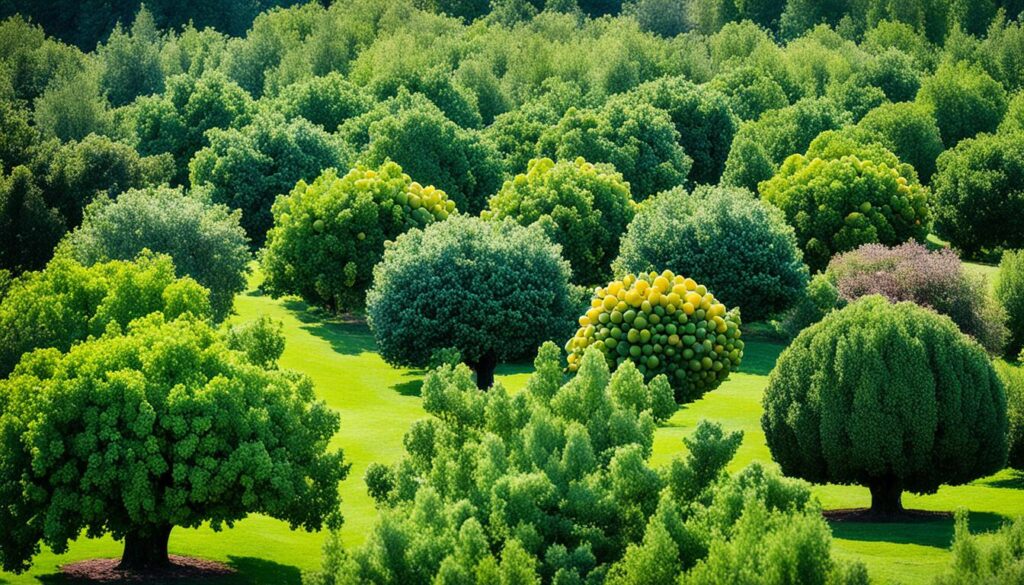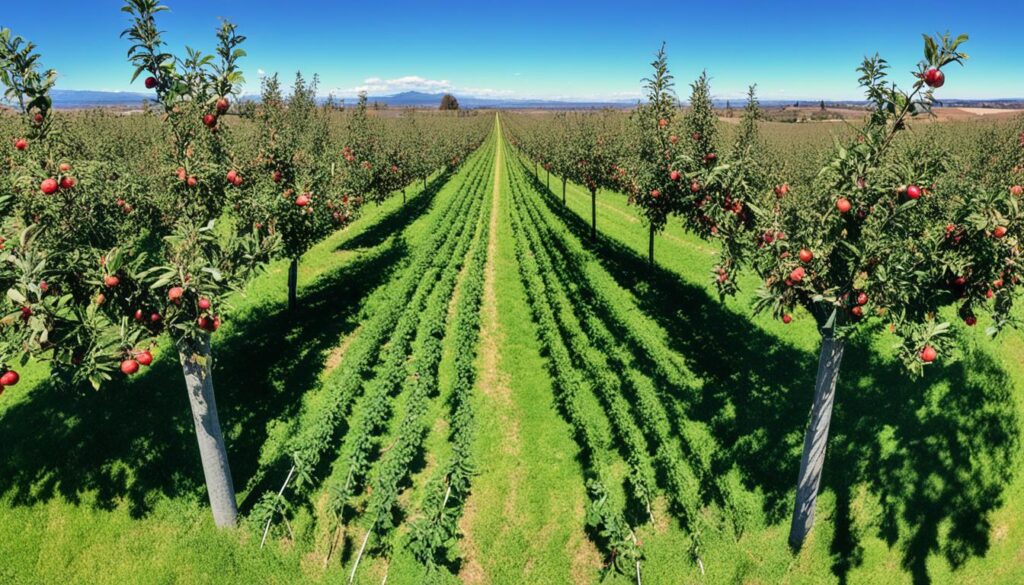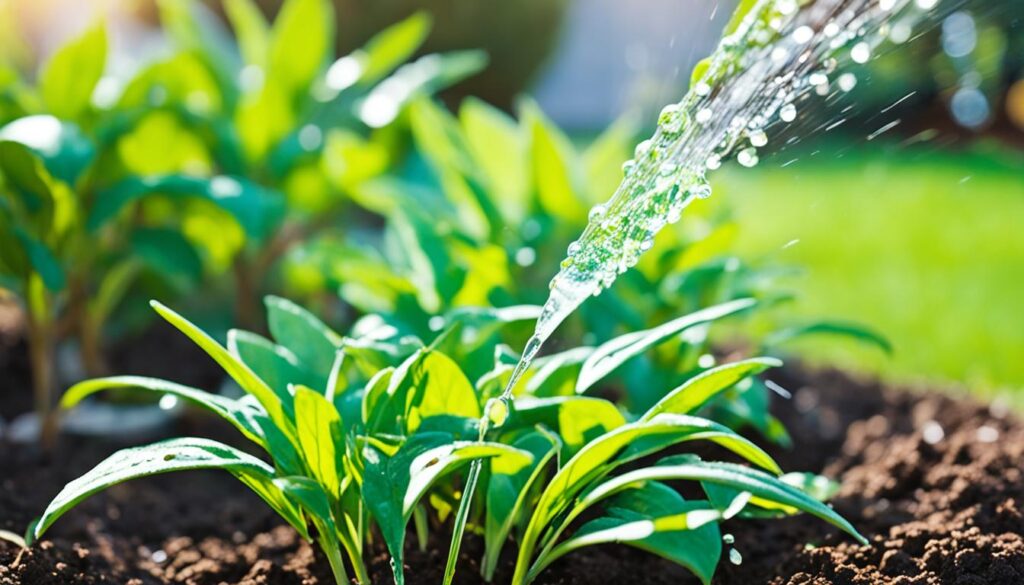Do you dream of a garden full of juicy, tasty fruit? Taking care of fruit trees takes some knowledge, but you can get great results. This guide will teach you how to pick the best trees and how to keep them healthy. You’ll learn about pruning and controlling pests. With these tips, you can enjoy fruit for many years.
Planning Your Fruit Tree Garden
Starting a fruit tree garden needs careful planning. Before you start, check your local climate and space. Knowing what different fruit trees need helps you make good choices for a successful garden.
Considering Your Climate and Space
First, look at your climate. Fruit trees need certain hours below 45°F in winter to produce well. Make sure your area can give them these chill hours. Also, think about how much space you have for your trees.
Most fruit trees like well-drained, rich soil and enough room to grow. They need space for their roots and leaves.
Determining Your Fruit Needs and Preferences
After checking your climate and space, pick the fruits you want to grow. Think about what fruits you like and need. Some trees, like apples and pears, need another tree to help them produce fruit.
Others, like some plums and cherries, can pollinate themselves. Learn about different trees to pick the best ones for your garden.
Planning your fruit tree garden well means you’ll get a lot of fruit. With the right climate, space, and trees, you can enjoy fresh, tasty fruits for many years.

Choosing the Right Fruit Tree Varieties
There are many fruit trees to pick from, like deciduous fruit trees and citrus trees. It’s important to choose ones that are disease-resistant and fit your local climate.
Deciduous Fruit Trees
Deciduous fruit trees, like apples and peaches, do well in areas with clear seasons. They need 200 to 1,700 hours of chilling each year. Think about how you’ll use the fruit and the tree’s size when picking one.
Citrus and Subtropical Fruit Trees
In warmer places, citrus and subtropical fruit trees are great choices. These include oranges and avocados. They don’t need as much chilling as other trees and do well in mild winter areas. Choose ones that fight off diseases well.
Looking into the needs of different fruit trees will help you pick the best ones for your garden. This way, you’ll get a good harvest.

| Fruit Tree Type | Chilling Requirement | Mature Size | Ideal for Urban Areas |
|---|---|---|---|
| Apples | 200-1,700 hours | Small to large | Yes, on semidwarf rootstock |
| Pears | 200-1,700 hours | Small to medium | Yes, on semidwarf rootstock |
| Peaches | 200-1,200 hours | Medium to large | Yes, on semidwarf rootstock |
| Citrus | Low chill | Medium to large | Yes, on dwarf or semidwarf rootstock |
| Avocado | Low chill | Large | Not recommended for urban areas |
Soil Preparation and Fertilization
Healthy soil is key for fruit tree growth and fruiting. Adding soil organic matter and using a natural fertility system are important. Avoiding artificial fertilizers helps too. This makes the soil good for soil microbes. These microbes help trees get nutrients and fight off pests and diseases. Good soil preparation and fertilization with organic matter lead to a big fruit harvest.
Building Healthy Soil with Organic Matter
For a great fruit tree garden, focus on soil fertility. Use organic matter like compost, aged manure, or cover crops. This makes the soil better at holding water and giving out nutrients. It also helps the good soil microbes that make nutrients available to your fruit trees. Don’t use artificial fertilizers because they can harm the soil balance.
- Add compost or aged manure to the soil before planting for more organic matter.
- Plant cover crops to add more organic matter and fix nitrogen from the air.
- Keep a natural fertility system by using less synthetic fertilizers.
By taking care of the soil’s health, your fruit trees will be healthy and productive. You won’t need harmful artificial fertilizers.
| Nutrient | Importance for Fruit Trees | Natural Sources |
|---|---|---|
| Nitrogen (N) | Promotes healthy growth and leaf development | Compost, animal manure, cover crops |
| Phosphorus (P) | Supports root development and fruit production | Bone meal, rock phosphate, organic matter |
| Potassium (K) | Enhances disease resistance and winter hardiness | Wood ash, greensand, mineral-rich rock powders |
| Calcium (Ca) | Crucial for cell wall strength and fruit quality | Lime, eggshells, gypsum |
| Micronutrients | Support overall plant health and vigor | Kelp, rock dust, compost |

Weather and Climate Considerations
Growing fruit trees means you need to think about the weather and climate. Things like too much rain, long droughts, hail, and big storms can hurt your trees. Knowing the weather and climate in your area helps you protect your trees. This way, you can get lots of fruit even when the weather is unpredictable.
One great way to keep your fruit trees safe is by making your garden diverse. Plant different kinds of fruit trees and add plants that grow under them. Also, keep the soil full of life with microbes. This makes your garden strong against changing weather.
| Climate Factor | Impact on Fruit Trees | Mitigation Strategies |
|---|---|---|
| Excessive Rain | Increased risk of disease, root rot, and poor fruit quality | Improve drainage, plant disease-resistant varieties, and consider raised beds |
| Drought | Stunted growth, reduced fruit production, and increased susceptibility to pests and diseases | Implement efficient irrigation systems, mulch to retain soil moisture, and choose drought-tolerant cultivars |
| Hail | Damage to leaves, branches, and developing fruit | Install hail netting or other physical barriers to protect trees |
| Extreme Temperatures | Disruption of dormancy, frost damage, and heat stress | Select fruit tree varieties suited to your specific climate, use row covers, and provide shade as needed |
By knowing your local weather and taking steps to protect your trees, you can have a garden that does well. It will give you lots of good fruit, even when the weather is tough.

Irrigation and Drainage Needs
Keeping the right amount of readily available water in the soil is key for your fruit trees’ health and growth. This balance comes from a mix of rainfall, irrigation, and proper drainage. It helps your trees get the moisture they need without getting too wet.
Maintaining Readily Available Water
Good fruit tree irrigation and drainage, along with rich soil, help your trees grow well and avoid problems like root rot. By managing the soil moisture right, you make the best conditions for your trees to grow and develop.
- Reference ET in California for trees during mid-summer is typically 86% of the average, with an average ETo of 0.3 inches per day.
- Different soil types hold varying amounts of water, for example, sand holds 1.0–1.5 inches of water per foot of soil depth, while clay holds 2.0–2.5 inches.
- An acre-inch is equivalent to 27,154 gallons of water.
- A medium-sized semi-dwarf fruit tree in California’s coast uses about 16 gallons of water per day, while in the Sacramento or San Joaquin Valley, it uses about 19 gallons per day.
| Soil Type | Water Holding Capacity |
|---|---|
| Sand | 1.0–1.5 inches per foot of soil depth |
| Clay | 2.0–2.5 inches per foot of soil depth |

By knowing your fruit trees’ water needs and your soil’s type, you can make a good fruit tree irrigation and drainage plan. This ensures your trees have the readily available water they need to do well.
The Importance of Thinning
Thinning is a key step for fruit trees that many forget. It makes the fruit quality and size better. By taking out too much fruit, the tree puts more energy into what’s left. This makes the fruit bigger, healthier, and tastier.
Thinning is key for a good fruit harvest every year. It stops the tree from getting too heavy with fruit, which can lead to no fruit the next year. It also stops branches from breaking under the weight of the fruit.
Thinning balances the fruit with the leaves. This lets the tree use its energy better for growing fruit. This can make next year’s fruit better by helping more fruit buds grow.
- Apples and pears should be thinned to one fruit per spur, leaving about one fruit for every 6 inches of branch.
- Apricots, peaches, nectarines, and plums should be thinned within 30 days of the end of bloom.
- Dwarf fruit trees should be thinned a bit extra after bloom to protect their young branches from being overloaded.
The best time to thin fruit trees is after pollination and when the fruit is still small. By thinning at the right time, you can make your fruit better. This makes your tree healthy and productive for many years.
Pruning Your Fruit Trees
Proper pruning is key to keeping your fruit trees healthy and productive. You should learn three main pruning techniques: establishment pruning, maintenance pruning, and renovation pruning.
Establishment Pruning
Do this pruning right after you plant your fruit trees. It sets their shape and structure for life. By removing competing leaders, you help the tree grow strong and balanced. This is crucial for future fruit production.
Maintenance Pruning
After your trees grow, you need to prune them every year. Maintenance pruning keeps them in shape and boosts fruit production. You’ll thin out crowded branches, remove dead wood, and shape the tree for better light and air.
Do this pruning in late winter or early spring when trees sleep. It’s gentler on the tree and keeps it healthy.
Renovation Pruning
If your fruit trees are neglected or too big, you might need renovation pruning. This can cut up to two-thirds of the tree to make it healthy again. It removes old, useless wood and lets in more light and air.
Do this pruning in late winter or early spring when the tree is asleep. Proper pruning keeps your fruit trees healthy, strong, and full of fruit.
Pest and Disease Management
Fruit tree pests and diseases can be tough to handle. But, you can keep your trees healthy with the right steps. Start by picking disease-resistant fruit tree varieties. Then, use a good pest and disease management plan.
Choosing trees that naturally fight off pests and diseases is a smart move. These disease-resistant fruit tree varieties need fewer chemicals. Pick the right trees for your area to ensure a healthy orchard.
Integrated Pest Management: A Holistic Approach
Using Integrated Pest Management (IPM) is key to stop pests and diseases. IPM means using many methods together, like:
- Regular monitoring and early detection of issues
- Promoting the growth of beneficial insects and organisms
- Implementing physical barriers and traps to deter pests
- Selectively using organic or synthetic pesticides as a last resort
This approach looks at the big picture to stop pests and diseases. It makes your orchard less welcoming to them.
| Common Fruit Tree Pests | Effective Management Strategies |
|---|---|
| Aphids | Insecticidal soap or summer oil application during the summer months |
| Codling Moth and Apple Maggot | Monitoring and targeted control measures for Apples and Pears |
| Plum Curculio | Mating disruption traps to monitor and control populations |
Stay alert, prevent problems, and act fast to stop pests and diseases. With the right steps, you can enjoy a great harvest every year.
Caring for Fruit Trees
Caring for fruit trees takes a lot of work but is very rewarding. It starts with planning and planting and goes on with pruning, thinning, and managing pests. Each step is key to keeping the trees healthy and productive for a long time. By caring for them well, fruit growers can enjoy lots of fruit for many years.
One important thing is making sure fruit trees get enough sunlight. They need a minimum of six hours of sun per day when they’re growing. It’s also important to plant them far enough away from paths and buildings. This means at least three feet away from sidewalks and driveways, and six feet away from buildings.
It’s also key to keep the soil around the trees moist. When planting a new tree, make sure to fully saturate the soil around the root ball with water. Use a moisture meter to check the soil’s moisture levels later. This helps make sure the trees get the right amount of water.
Pruning and fertilizing are also vital for fruit trees. Prune them in summer to keep them the right size. In winter or early spring, prune more carefully to fix any problems like crossed branches or dead limbs. The type of fertilizer you use depends on the tree’s age. Use nitrogen-rich fertilizer when they’re young, and a 3-12-12 fertilizer blend when they’re bigger.
Caring for fruit trees is a journey that takes patience and hard work. By doing things right, fruit growers can make their fruit trees last longer and produce more. This means they can enjoy a lot of fruit for many years.
Harvest and Storage Techniques
Learning how to harvest and store your fruit is key to a great harvest. Picking your fruits when they are ripe is crucial for the best taste and texture. For example, stone fruits like peaches and nectarines are ready when they turn color and start to soften.
Using a refractometer to check sugar levels can also tell you when to pick. A reading over 10% means the fruits will ripen well.
After picking, handle your fruits carefully and store them right to keep them fresh. Some fruits, like plums and apricots, might be better for canning or drying. For apples and pears, tests like the starch test can help you know when to pick.
Keeping the right temperature and humidity in storage keeps your fruits fresh and tasty. By learning these techniques, you can enjoy your fruit harvest to the fullest. Whether you’re saving fruits for later or eating them now, knowing how each fruit ripens and stores is important.



